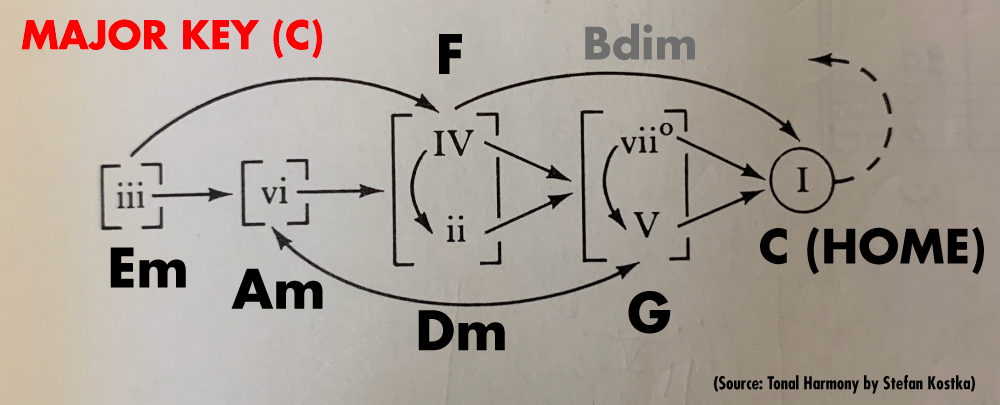
This chord chart is a "tried and true" flow-chart for coming up with standard chord progressions, from a very popular college music theory textbook. This is burned into my brain and has been since college. I use it constantly.
Here's how it works:
In this case we're in the key of C. So, Start with a C Chord.
From C, you can go to ANY other chord to the left of it, then you work your way back to the right and get back home to C.
Following the arrows, if you moved from C to F, you could then either go to Dm or G.
This also sort of "ranks" the chords in their relative importance / frequency in music, and is also based on the circle of fifths. Chords farther to the right will tend to appear more often in more simple music. The farther you go out to the left, the longer you can take your time going back to the right, and the more of a journey the chord progression will be. You could go from C all the way out to Em, then work your way back, hitting all the chords on the way.
Note: B Diminished is sort of an oddball chord there because it's more of a substitution for the G chord, which is why I greyed it out. It's optional and you could just skip it in general unless you're writing classical music.
Try going through that flowchart and coming up with chord progressions, see how they sound. What you might find after a while is that you've exhausted a lot of the possibilities, and you'll start to "get" where the chords want to go next. At first, as a teenager, this chart really upset me -- how can most music all come down to a simple chart?! But this really is the basic for most of the music out there. A very handy formula / tool!
What I do for my songs is follow that general flowchart and then intentionally BREAK it where I want to, depending on my goal. Then start over from the broken spot and follow the rules a bit, then break it again. That ends up being a matter of your own taste.
There is also a version of this for minor keys, but it's more complicated.
Another note: at some point you'll hear the argument that when writing music, MELODY comes first, and THEN chords. But I tend to write them both at the same time, to support and react to each other. Sometimes the melody will alter the chords, and sometimes the chords will alter the melody. Some may also find this chart too formulaic and sterile. But I recommend learning it as a tool which you can choose to use or not. I have used the heck out of it. :)
-Carl.
Carl King[br]GuitarTricks Video Director / Producer